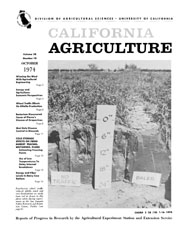


University of California
California Agriculture



|
|||
|
|||

Cover:
Post-harvest wheel traffic reduced alfalfa stand and root development on sandy loam soil as shown in this photo taken during experiments at the San Joaquin Valley Research and Extension Center, Parlier.
October 1974
Volume 28, Number 10 News and opinion |
|||
|
University of California, 1301 S. 46th St., Bldg. 478 Richmond, CA
|